3D printing of protein molecules
So, the fashion for 3D printing has reached our modest institution, proudly called the Laboratory of Molecular Biology . A couple of weeks ago, the workshops bought a 3D printer, which triggered a heated discussion among biologists — what a new thing might be useful for. Physiologists, for example, have already gathered to print some complicated parts for a new mechanism designed to test all behavioral reactions in rats. We are engaged in determining the three-dimensional structure of the protein by X-ray analysis (and, for some time, cryo-electron microscopy) and for us the benefits of 3D printing are not so obvious. Accordingly, we rummaged through the Internet to understand what the people are typing in terms of protein structures. The resulting reviewer with beautiful pictures and video of printed models is under the cut.
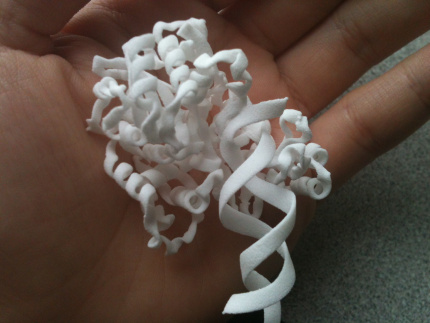
More than a hundred years ago, comrade Friedrich Engels rightly noted, “life is a way of existence of protein bodies”. That is, our bodies are largely made of protein and proteins perform the most important functions in our body - structural (the shape of the cells rests on the protein cytoskeleton), motor (muscles contract due to the cunning work of motor proteins), enzymatic (say, food is digested thanks to protein-enzymes ), transport (oxygen from the lungs to the tissues carries hemoglobin protein), and so on; in a word, without a squirrel - nowhere.
Accordingly, it is very interesting to learn how proteins work. From the point of view of a biochemist, a protein is such a black box. You can give him different substances at the entrance and then see what happens at the exit (at what speed, etc.). The definition of the three-dimensional structure of the protein molecule in a sense opens this black box, the structure of the protein is a diagram of how the black box is arranged inside. It is not always possible to immediately understand from the structure how the protein works, but the structure certainly opens our eyes and allows us to plan further experiments.
')
Protein is a very large molecule (macromolecule). From a chemical point of view, it is a linear polymer, with a length from 70 to more than 1000 monomers-amino acids. Due to the different side groups of amino acids, the long protein molecule folds into a compact globule, each protein has its own styling. It is the structure of the folded protein that scientists determine. The leading method is X-ray analysis, which allows to calculate the coordinates of protein atoms by X-ray diffraction on a crystal of the corresponding protein. Scientists-crystallographers have a convention - any specific protein structure should be laid out in the Protein Data Bank Data Bank ( PDB, Protein Data Bank ), in which the number of structures has already exceeded 100,000. Accordingly, all structures are publicly available, they can be downloaded, viewed , print on a 3D printer and so on. More on the structure of the protein I wrote on Habré earlier; in more detailed form about the structure can be read here .
It should be noted that the task of displaying the structure of a protein is not so simple. Protein consists of several thousand atoms, which, at first glance, seem like creepy porridge (“a” and “c” in the picture). Different tasks are used for different tasks. For example, if we want to understand how the main protein chain is laid, then we want to display the protein in a schematic form, where only the main chain stroke (“g” in the picture) will be indicated using special symbols - spirals for alpha helices, arrows for designations of beta-folded sheets ("d", "e" in the picture).
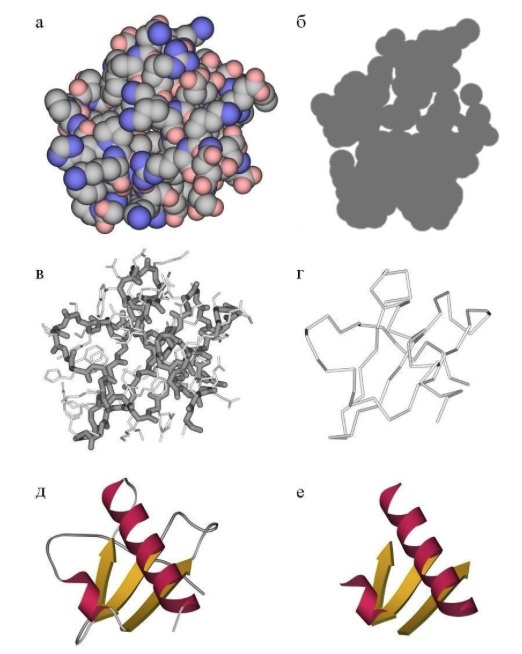
If we want to see protein as a bulk body, then we can display the surface of the protein (then it becomes like a potato); the surface can be painted using different parameters. The most useful thing is to paint by electrostatic potential, then you will immediately see the charged areas.
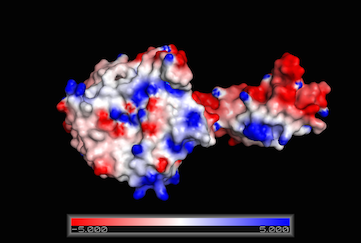
If we want to understand how a drug molecule or chemical substrate binds to our protein, then we display only a small part of the protein - the active center of the enzyme, a small amount of key amino acids directly interacting with the drug.
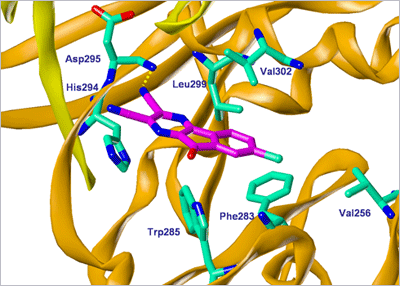
For a start, some entertaining videos.
Here is a very clear demonstration of how many protein molecules of actin are assembled into so-called “actin filaments”, which form the cytoskeleton on which the entire shape of our cells rests, plus it also works in muscles. Separate actin molecules are printed on a 3D printer, the surface is electrostatically painted.
Here's something cooler: a molecule of hemoglobin that carries oxygen in our body (red blood cells are stuffed with this protein). Hemoglobin consists of four subunits (individual protein molecules), plus a small heme molecule that carries an iron atom that binds oxygen is bound to hemoglobin. In the manufacture of this model used more complex those. the process and, as a result, the transparent outer surface reflects the real surface of the protein molecule, and inside, under the transparent outer layer, multi-colored alpha-helices and other elements of the secondary structure are visible, clearly showing the progress of the main protein chain. The video shows the assembly of a whole hemoglobin from four subunits, subunits are mounted on magnets. At the very end, a small heme molecule is thrust into place.
Here is another video of the same model, here the secondary structure is better seen on it and it is shown how lowering the model into the water allows you to see the secondary structure more contrastly. Another difference is that in this model the outer layer of the protein is not just transparent, as in the previous version, but also slightly tinted with electrostatic potential:
These videos are taken from a Japanese enthusiast's channel for 3D printing of the Kawakami Masaru protein, more videos with different printed protein structures can be found here:
http://www.youtube.com/channel/UCsrgChR36VUMVy8GejyuD0Q/videos
Of course, cunning businessmen could not help but pick up the idea and the production of molecular beauty has already been put on stream: such cognitive structures of the protein can already be bought .

Again, if you want to print your protein, it’s not necessary to buy a 3D printer. There are already a sufficient number of companies selling both ready-made kits (for example, three-dimensional models of DNA), and printing any protein to order. For example, 3D Molecular Designs .
On the issue of business: in addition to 3D printing itself, companies have long existed that are ready to print the three-dimensional structure of your favorite protein in a transparent crystal . The idea is quite in demand from structural biologists: for example, a similar crystal was presented by the chief of one of my friends after she identified the protein structure first in her life. The scientific value of such a crystal tends to zero, but it looks very beautiful and aesthetic.
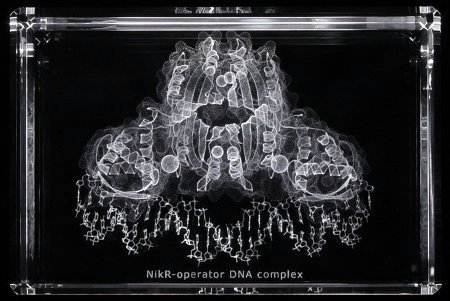
If someone thinks it's all a joke and self-indulgence - not at all. The seriousness of the situation is shown by the recently launched repository of ready-made 3D models from the US NIH - National Institutes of Health in collaboration with the National Library of Medicine (these are the most serious structures that are part of the US Department of Health). In addition to high protein structures (X-ray crystallography) and low resolutions (cryo-electron microscopy), models of test-tube supports and other laboratory trifles are visible in the repository. The repository was created, as I understand it, to improve the internal exchange of models in the NIH. Now there are 452 models in it.
If you are inspired by the above pictures and have access to a 3D printer, then printing the protein structure itself is quite easy. There are many step-by-step instructions on the Internet, here are two of the most intelligent and detailed:
http://www.instructables.com/id/3D-Print-a-Protein-Modeling-a-Molecular-Machine/?ALLSTEPS
http://www.over-engineered.com/projects/3d-printed-protein
In short, you must first install one of the programs to display protein structures . Then - find the structure for printing. All structures are located in Protein Data Bank , there is a search by keyword. In addition to the search, they have a marvelous project “Molecule of the Month” - they choose a certain protein and tell in detail about its structure and function for a wide audience of non-professionals. The main page of the project looks frightening because of the abundance of incomprehensible names of proteins, but if you start clicking on the links, there will be beautiful pictures and clear descriptions of the work and structure of one or another protein. I hope this information will help you choose a protein for printing.
After the structure is loaded (there is a wonderful “Download files” button in Protein Data Bank) and its display in the corresponding program, you need to choose in what form you want to print the molecule. In the instructions above, it is proposed to display the protein in the form of a surface painted by electrostatic potential, export the surface, convert it into a print format, and - voila! A potato-like bulk protein model is really easy to type.
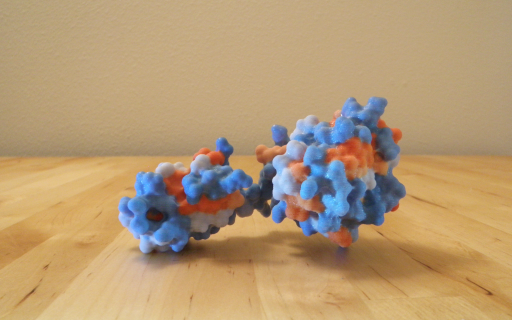
However, it would be interesting to print and, say, a schematic representation of the main protein chain, something like this (here, as far as I can see, the complex of protein and DNA):

The only such skeletal structure of the protein may be fragile. For such printing, it is recommended to use the program to display Chimera protein structures, as it can directly export .stl files understood by most 3D printers. Accordingly, any type of molecule you choose in Chimera is easily exported and can be printed, including a skeletal representation. Here is a short video presentation explaining this process a bit:
As we have just seen, people actively print protein structures. The question remains open: why do they do it? So far the only answer is for educational, demonstration, and educational purposes. Proteins - complex three-dimensional objects and the ability to hold such a "molecule" in your hand, of course, contributes to the understanding of how the protein is arranged and works. Plus, many squirrels are just visually beautiful. Printing the skeletal structure of a protein can be a rather serious technical challenge, and then an impressive demonstration of the possibilities of 3D printing. So, if you have a 3D printer, free time and enthusiasm ... You know what to do!
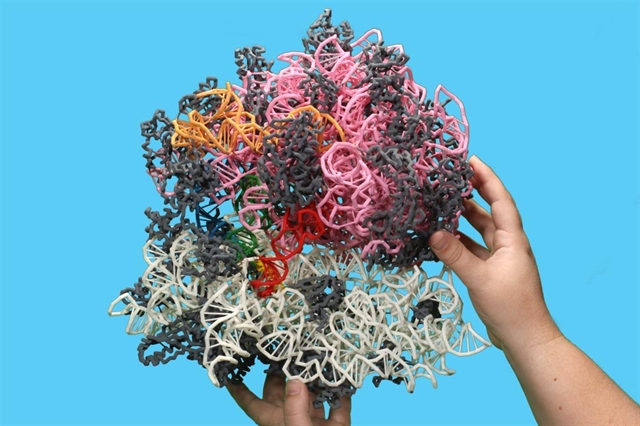
This beauty is a ribosome .

Briefly about protein structures
More than a hundred years ago, comrade Friedrich Engels rightly noted, “life is a way of existence of protein bodies”. That is, our bodies are largely made of protein and proteins perform the most important functions in our body - structural (the shape of the cells rests on the protein cytoskeleton), motor (muscles contract due to the cunning work of motor proteins), enzymatic (say, food is digested thanks to protein-enzymes ), transport (oxygen from the lungs to the tissues carries hemoglobin protein), and so on; in a word, without a squirrel - nowhere.
Accordingly, it is very interesting to learn how proteins work. From the point of view of a biochemist, a protein is such a black box. You can give him different substances at the entrance and then see what happens at the exit (at what speed, etc.). The definition of the three-dimensional structure of the protein molecule in a sense opens this black box, the structure of the protein is a diagram of how the black box is arranged inside. It is not always possible to immediately understand from the structure how the protein works, but the structure certainly opens our eyes and allows us to plan further experiments.
')
Protein is a very large molecule (macromolecule). From a chemical point of view, it is a linear polymer, with a length from 70 to more than 1000 monomers-amino acids. Due to the different side groups of amino acids, the long protein molecule folds into a compact globule, each protein has its own styling. It is the structure of the folded protein that scientists determine. The leading method is X-ray analysis, which allows to calculate the coordinates of protein atoms by X-ray diffraction on a crystal of the corresponding protein. Scientists-crystallographers have a convention - any specific protein structure should be laid out in the Protein Data Bank Data Bank ( PDB, Protein Data Bank ), in which the number of structures has already exceeded 100,000. Accordingly, all structures are publicly available, they can be downloaded, viewed , print on a 3D printer and so on. More on the structure of the protein I wrote on Habré earlier; in more detailed form about the structure can be read here .
It should be noted that the task of displaying the structure of a protein is not so simple. Protein consists of several thousand atoms, which, at first glance, seem like creepy porridge (“a” and “c” in the picture). Different tasks are used for different tasks. For example, if we want to understand how the main protein chain is laid, then we want to display the protein in a schematic form, where only the main chain stroke (“g” in the picture) will be indicated using special symbols - spirals for alpha helices, arrows for designations of beta-folded sheets ("d", "e" in the picture).

If we want to see protein as a bulk body, then we can display the surface of the protein (then it becomes like a potato); the surface can be painted using different parameters. The most useful thing is to paint by electrostatic potential, then you will immediately see the charged areas.

If we want to understand how a drug molecule or chemical substrate binds to our protein, then we display only a small part of the protein - the active center of the enzyme, a small amount of key amino acids directly interacting with the drug.

Printed Protein Structures
For a start, some entertaining videos.
Here is a very clear demonstration of how many protein molecules of actin are assembled into so-called “actin filaments”, which form the cytoskeleton on which the entire shape of our cells rests, plus it also works in muscles. Separate actin molecules are printed on a 3D printer, the surface is electrostatically painted.
Here's something cooler: a molecule of hemoglobin that carries oxygen in our body (red blood cells are stuffed with this protein). Hemoglobin consists of four subunits (individual protein molecules), plus a small heme molecule that carries an iron atom that binds oxygen is bound to hemoglobin. In the manufacture of this model used more complex those. the process and, as a result, the transparent outer surface reflects the real surface of the protein molecule, and inside, under the transparent outer layer, multi-colored alpha-helices and other elements of the secondary structure are visible, clearly showing the progress of the main protein chain. The video shows the assembly of a whole hemoglobin from four subunits, subunits are mounted on magnets. At the very end, a small heme molecule is thrust into place.
Here is another video of the same model, here the secondary structure is better seen on it and it is shown how lowering the model into the water allows you to see the secondary structure more contrastly. Another difference is that in this model the outer layer of the protein is not just transparent, as in the previous version, but also slightly tinted with electrostatic potential:
These videos are taken from a Japanese enthusiast's channel for 3D printing of the Kawakami Masaru protein, more videos with different printed protein structures can be found here:
http://www.youtube.com/channel/UCsrgChR36VUMVy8GejyuD0Q/videos
Of course, cunning businessmen could not help but pick up the idea and the production of molecular beauty has already been put on stream: such cognitive structures of the protein can already be bought .

Again, if you want to print your protein, it’s not necessary to buy a 3D printer. There are already a sufficient number of companies selling both ready-made kits (for example, three-dimensional models of DNA), and printing any protein to order. For example, 3D Molecular Designs .
On the issue of business: in addition to 3D printing itself, companies have long existed that are ready to print the three-dimensional structure of your favorite protein in a transparent crystal . The idea is quite in demand from structural biologists: for example, a similar crystal was presented by the chief of one of my friends after she identified the protein structure first in her life. The scientific value of such a crystal tends to zero, but it looks very beautiful and aesthetic.

If someone thinks it's all a joke and self-indulgence - not at all. The seriousness of the situation is shown by the recently launched repository of ready-made 3D models from the US NIH - National Institutes of Health in collaboration with the National Library of Medicine (these are the most serious structures that are part of the US Department of Health). In addition to high protein structures (X-ray crystallography) and low resolutions (cryo-electron microscopy), models of test-tube supports and other laboratory trifles are visible in the repository. The repository was created, as I understand it, to improve the internal exchange of models in the NIH. Now there are 452 models in it.
How to print protein structure yourself
If you are inspired by the above pictures and have access to a 3D printer, then printing the protein structure itself is quite easy. There are many step-by-step instructions on the Internet, here are two of the most intelligent and detailed:
http://www.instructables.com/id/3D-Print-a-Protein-Modeling-a-Molecular-Machine/?ALLSTEPS
http://www.over-engineered.com/projects/3d-printed-protein
In short, you must first install one of the programs to display protein structures . Then - find the structure for printing. All structures are located in Protein Data Bank , there is a search by keyword. In addition to the search, they have a marvelous project “Molecule of the Month” - they choose a certain protein and tell in detail about its structure and function for a wide audience of non-professionals. The main page of the project looks frightening because of the abundance of incomprehensible names of proteins, but if you start clicking on the links, there will be beautiful pictures and clear descriptions of the work and structure of one or another protein. I hope this information will help you choose a protein for printing.
After the structure is loaded (there is a wonderful “Download files” button in Protein Data Bank) and its display in the corresponding program, you need to choose in what form you want to print the molecule. In the instructions above, it is proposed to display the protein in the form of a surface painted by electrostatic potential, export the surface, convert it into a print format, and - voila! A potato-like bulk protein model is really easy to type.

However, it would be interesting to print and, say, a schematic representation of the main protein chain, something like this (here, as far as I can see, the complex of protein and DNA):

The only such skeletal structure of the protein may be fragile. For such printing, it is recommended to use the program to display Chimera protein structures, as it can directly export .stl files understood by most 3D printers. Accordingly, any type of molecule you choose in Chimera is easily exported and can be printed, including a skeletal representation. Here is a short video presentation explaining this process a bit:
Conclusion (or what for goat accordion)
As we have just seen, people actively print protein structures. The question remains open: why do they do it? So far the only answer is for educational, demonstration, and educational purposes. Proteins - complex three-dimensional objects and the ability to hold such a "molecule" in your hand, of course, contributes to the understanding of how the protein is arranged and works. Plus, many squirrels are just visually beautiful. Printing the skeletal structure of a protein can be a rather serious technical challenge, and then an impressive demonstration of the possibilities of 3D printing. So, if you have a 3D printer, free time and enthusiasm ... You know what to do!

This beauty is a ribosome .
Source: https://habr.com/ru/post/238451/
All Articles